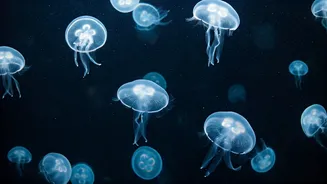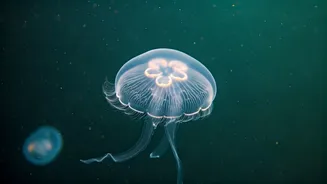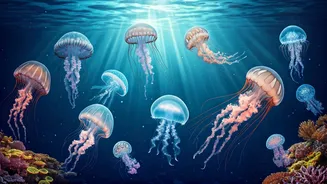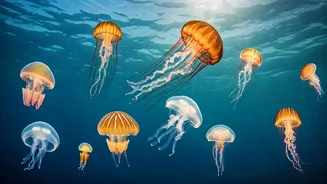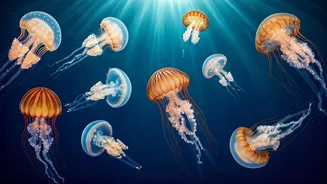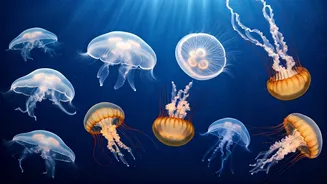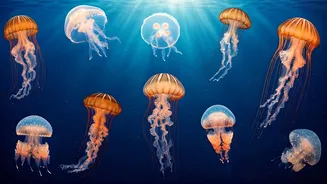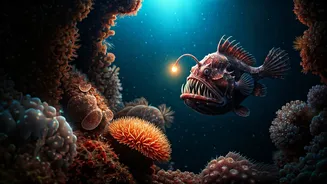Introduction to Jellyfish
Jellyfish, despite their name, aren't actually fish. They are gelatinous, free-swimming marine animals belonging to the phylum Cnidaria. Lacking brains,
blood, and bones, they rely on a simple nervous system for survival. Their bodies are primarily composed of water, giving them a unique, almost otherworldly appearance. They've existed for over 500 million years, showcasing their remarkable adaptability, thriving in diverse aquatic ecosystems from shallow coastal waters to the deepest ocean trenches. Their captivating forms and varied colors make them a source of wonder, inspiring both scientific study and artistic expression. Understanding their biology and role in marine ecosystems is crucial to appreciate their importance and contribute to their conservation.
The Moon Jellyfish
The Moon Jellyfish (Aurelia aurita) is one of the most recognized and widely distributed jellyfish species globally. Characterized by its translucent, moon-like bell, it showcases a subtle, elegant beauty. These jellyfish typically have a diameter of about 25-40 centimeters. Found in coastal waters, they're relatively harmless to humans, their sting being mild. Moon jellyfish are voracious predators, feeding on plankton and other small organisms. Their lifecycle involves a complex alternation between a polyp stage, attached to the seabed, and the free-swimming medusa stage we recognize. The Moon Jellyfish plays a crucial role in marine food webs, and their abundance reflects the overall health of their ecosystem. Observing them in the ocean provides a glimpse into the delicate balance of aquatic life, emphasizing the interconnectedness of all living things within these ecosystems.
The Lion's Mane
The Lion's Mane Jellyfish (Cyanea capillata), renowned as the largest known jellyfish species, commands attention with its imposing size and stunning appearance. The bell can reach over 2 meters in diameter, with tentacles extending up to 36 meters, exceeding the length of a blue whale. Its vibrant colors range from orange to deep red, adding to its visual appeal. Found primarily in cold, northern waters of the Arctic and North Atlantic, the Lion's Mane possesses a potent sting used to capture prey. Its massive tentacles contain thousands of stinging cells called nematocysts. This species is an efficient predator, preying on fish, smaller jellyfish, and other marine organisms. These jellyfish represent a significant part of the marine ecosystem. Their size and presence highlight the biodiversity and grandeur found beneath the ocean's surface. Understanding their place within the marine ecosystem is essential for protecting the delicate balance of the ocean's food chain.
The Box Jellyfish
Box Jellyfish, members of the class Cubozoa, are known for their distinctive cube-shaped bells and potent venom, considered the deadliest marine creatures. These jellyfish often have a transparent appearance, making them difficult to spot. Their venom contains toxins that target the heart, nervous system, and skin cells, resulting in severe pain, paralysis, and sometimes death. Found primarily in warm, tropical waters of the Indo-Pacific, they use their advanced visual system to hunt prey. The Box Jellyfish have complex eyes, allowing them to navigate their environment with remarkable precision. Although dangerous, their survival strategy highlights the incredible adaptability that marine life showcases. Understanding their behavior and distribution is important to comprehend the potential dangers and develop effective prevention strategies within affected coastal regions.
The Portuguese Man-of-War
The Portuguese Man-of-War (Physalia physalis) is often mistaken for a jellyfish, but it's actually a siphonophore – a colony of specialized organisms working together. Characterized by its gas-filled, iridescent float, it drifts on the ocean's surface, propelled by wind and currents. Trailing beneath are long, venomous tentacles that can extend up to 30 meters, used to capture prey. Found in warm, tropical, and subtropical waters worldwide, its sting is painful to humans. The Portuguese Man-of-War plays a role in marine ecosystems, contributing to the food chain and acting as a habitat for certain species. Their presence offers a glimpse into the complex interactions within marine environments. Protecting this unique species, and the environments it inhabits, safeguards the delicate balance of life in our oceans.
The Irukandji Jellyfish
The Irukandji jellyfish (Carukia barnesi) is a small, nearly transparent species, renowned for its extremely potent venom, which can cause Irukandji syndrome. This syndrome is a collection of severe symptoms, including intense muscle cramps, back pain, vomiting, and a sense of impending doom. Found in the waters off Northern Australia, the Irukandji are a major health concern. They are small, typically less than an inch in diameter, making them difficult to see. Their venom is exceptionally potent, causing a complex and life-threatening reaction. Researching this species is essential to understanding its impact on human health and developing effective treatments. Awareness of their presence and the dangers they pose is crucial for those in affected regions. The Irukandji jellyfish serves as a critical example of the power and risks in the marine environment.
The Flower Hat Jellyfish
The Flower Hat Jellyfish (Olindias formosa) is a strikingly beautiful species known for its bell-shaped form and colorful, flower-like appearance. Its bell is adorned with numerous tentacles and oral arms, creating a visual display. They are found in the Indo-Pacific, often near rocky reefs and coastal areas. While their sting is not as dangerous as some other species, it can still cause pain and irritation. These jellyfish are active predators, utilizing their tentacles to capture small fish and other prey. Their vibrant colors and unique form make them a favorite for underwater photographers and marine enthusiasts. The Flower Hat Jellyfish serves as a reminder of the beauty and diversity hidden within our oceans. Appreciating their aesthetics and understanding their biology helps to encourage a deeper respect for marine life and environmental conservation.
The Upside-Down Jellyfish
The Upside-Down Jellyfish (Cassiopea andromeda) demonstrates a unique behavior. They rest upside down on the seafloor, exposing their tentacles to the sun. This positioning allows them to host symbiotic algae within their tissues, which provide them with nutrients through photosynthesis. These jellyfish are found in shallow, tropical waters, such as mangroves, seagrass beds, and lagoons. Their symbiotic relationship is an example of the complex interactions in marine ecosystems. By adopting this unique posture, they have adapted to their environment in a way that provides them with a consistent food source. They often live in large groups, creating underwater meadows of pulsating organisms. Their lifestyle serves as a testament to the adaptability of life in marine environments and highlights the importance of the balance between different species.
The Crystal Jellyfish
The Crystal Jellyfish (Aequorea victoria) is named for its transparent bell. This makes them almost invisible in their natural environment. Found in the Pacific Ocean, Crystal Jellyfish are famous for their bioluminescence. They contain a protein called green fluorescent protein (GFP), which emits a brilliant green light when exposed to ultraviolet light. This property has revolutionized biological research, enabling scientists to study and understand cellular processes in unprecedented ways. The discovery of GFP led to a Nobel Prize in Chemistry in 2008. These jellyfish are a testament to the potential found in nature. Their impact on scientific advancements emphasizes the importance of understanding and protecting marine ecosystems. Studying these jellyfish and their unique properties benefits scientists around the globe.
The Immortal Jellyfish
The Immortal Jellyfish (Turritopsis dohrnii) is a unique species. It can revert to its polyp stage after reaching sexual maturity, effectively becoming immortal. This remarkable ability involves cell transdifferentiation, allowing the jellyfish to transform back to its juvenile form and then resume its life cycle. Native to the Caribbean, this tiny jellyfish, measuring only about 4.5 millimeters in diameter, has spread globally through ballast water in ships. This makes it an invasive species in many regions. Although the Immortal Jellyfish can regenerate and has the potential to live indefinitely, it still faces threats, such as predation and environmental stressors. The Immortal Jellyfish's ability is a reminder of the wonders of biology. Research on it could provide valuable insights into aging and regeneration. It inspires us to appreciate the resilience and adaptability of life, even in the most unusual of forms.
